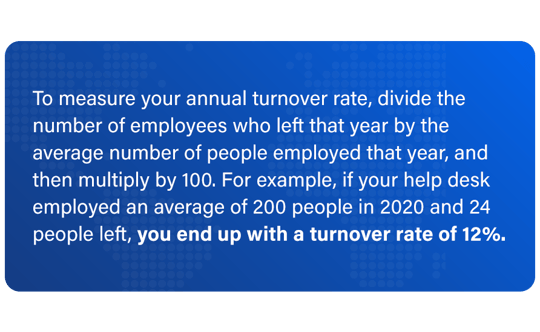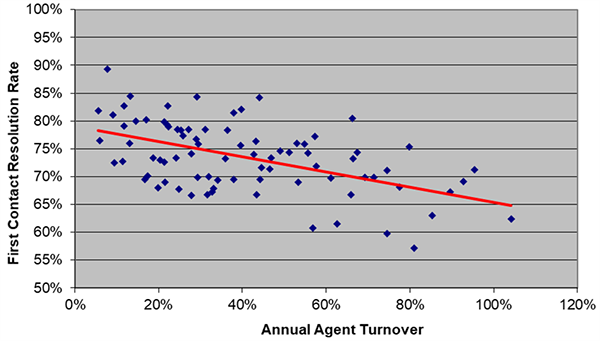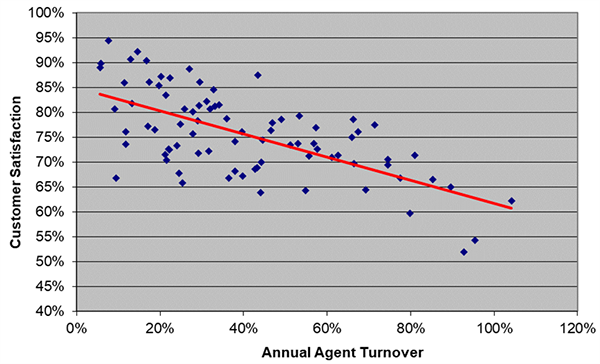Experienced, knowledgeable help desk agents are worth their weight in gold. Not only do they provide excellent service, but they can also help guide and mentor other agents, raising the performance and morale of your entire help desk.
So, the last thing you want is to see your best agents jump ship to another company.
No matter how wonderfully you treat your help desk employees, turnover is an inevitable part of managing people. You may have “good” turnover, where agents get promoted to other positions within the company, or “bad” turnover, where an agent leaves or is let go. In either case, however, turnover leaves a vacancy to fill.
Is your help desk turnover rate acceptable … or alarming? What are some of the causes of turnover and what effects can it have on your company? And how can you improve your employee retention rate and keep great agents around for the long haul?
How to Spot Problems with Help Desk Employee Retention
Naturally, your first step in discovering if your help desk has a problem with help desk employee retention is to establish your benchmark turnover rate. You can only manage agent turnover if you measure it.

Once you know what your average annual agent turnover rate is, compare it against industry benchmarks. The average annual turnover rate for agents in U.S. contact centers is 37%, according to research conducted by The Quality Assurance & Training Connection. This rate is more than double the average turnover rate for all occupations in the U.S. (Bear in mind that this statistic is for contact centers in general, not IT help desks in particular.) The folks at HDI, who focus on training and consultancy for technical support and service management, confirm that the average turnover in this field is 40% per year.
According to the latest US Contact Center HR & Operational Benchmarking Report, published by Contact Babel, a leading analyst firm for the contact center industry, agent attrition rates vary depending on the size of the organization. Median agent attrition in large (200+ seat) operations is more than twice that of small (<50 seat) contact centers.
Whether your current turnover rate is alarmingly high or blessedly low, the key to consistently low turnover is to figure out why turnover happens and what steps you can take to keep employee retention high.
Why Help Desk Agent Turnover Happens
Agents leave help desk positions for any number of reasons, but there are a few common causes.
- Starting salary: Where they start determines how long they stay. New hire attrition rates are demonstrably influenced by starting salaries. Agents who are paid an average starting salary of $23,202 have an attrition rate of more than 25% within the first six months on the job, compared with agents who are paid an average starting salary of $32,461. Their attrition for the same period is 10% or less. (Contact Babel)
- Employers’ market: If the unemployment rate in your area is high, there are always more candidates for job postings than there are positions available. Some employers, lulled by how easy it is to find replacements, may let their employee retention efforts slide.
- Overqualified agents: Organizations often staff their IT help desks with employees who have tremendous technical knowledge but who lack two of the skills most valued in contact center agents, namely, empathy and active listening. Agents who have good technical skills but poor customer service skills typically don’t last long in the role.
- Agent goals: At many small- to mid-size organizations, employees treat their position in the IT help desk as a steppingstone to another position within the organization. Their goal is to endure the help desk position for six months or a year before taking a position as a developer, engineer, or database administrator within the same organization. When these internal positions open up, the agent leaves the help desk. And if those internal opportunities don’t materialize? The agent leaves the organization.
The Costs of Help Desk Employee Turnover
Organizations in the U.S. must spend roughly $12,000 to replace a help desk agent. This amount includes the direct costs of recruiting, screening, interviewing, onboarding, and training a new agent. But it also includes many indirect costs, such as:
- Reduced productivity as the new agent learns on the job
- Overtime expenses incurred when backfilling vacant positions
- Loss of institutional memory (the departing agent walks out the door with a head full of knowledge and experience), which hinders operations and performance
- Reduced employee morale
These costs, unsurprisingly, can have significant effects on service levels and other KPIs. HDI revealed that the higher the annual agent turnover, the lower the first contact resolution rate – and the lower the customer satisfaction rate.


How to Improve Your Help Desk Employee Retention Rate
When it comes to reducing turnover, think of how a good marriage operates: If you only focus on the relationship once the red flags are up and the other party is halfway out the door, you’re not going to have long-term success. Instead, focus on what you must do to set agents up for success and keep them happy. Your goal is to be proactive, not reactive.
- Hire based on emotional intelligence (EQ), not IQ: Hire candidates who are empathetic and good listeners, and who genuinely like talking to people. Technical skills can be learned. Soft skills, however, are much harder to teach.
- Review your training: A leading cause of high agent turnover is stress. New agents who are learning on the job experience stress while fielding escalating calls. Look at your new agent onboarding, initial training, and ongoing development to make sure you are setting your agents up for success from day one.
- Recognize your agents: When agents feel invisible and unappreciated, they start looking at the job boards. Make an effort to acknowledge agents and empower them: 50% of employees will stay if they are tangibly recognized, according to a study by CareerBuilder.
- Give agents the tools they need: Working an eight-hour shift tied to a phone is hard on anyone. Add to this the monotony of fielding the same types of calls day in, day out, and you can appreciate why some agents yearn to escape. Alleviate this monotony with technology, such as live chat, email, and self-serve options, and by resolving help-desk issues on social media.
- Monitor absenteeism: Turnover is often preceded by absenteeism. Before agents quit, they quit coming in. The result is that productivity drops, the customer experience worsens, and overworked agents disengage. Find the reasons behind high absenteeism and address them.
Consider Outsourcing Your Help Desk
One sure way to reduce your help desk agent turnover is to outsource part (or all) of your help desk. Outsourcing improves your bottom line, increases your operational efficiency, and eliminates your agent turnover headaches at the same time.
When you outsource, your help desk service provider picks up the slack when you have an uptick in internal turnover. They easily absorb the extra workload because they already have the staff on hand to jump in and be productive immediately.
If you like, you can use a hybrid model. Rather than manage your help desk 100% in-house, or outsource 100% of it to a third-party firm, you go for a combination approach:
- Outsource off hours: Outsource your help desk function for those times your office is closed, such as evenings, nights, and weekends. For the rest of the time, your internal help desk team handles everything.
- Outsource Tier 1: Outsource the Tier 1 calls that are commonplace, simple, and quick to resolve (such as password resets). Keep the more complex tickets in-house.
By the way, Global Help Desk Services Inc. provides help desk outsourcing services to enterprise-level companies. Unlike many of our competitors, we are based 100% in the United States, and we focus exclusively on delivering help desk services (no managed services, no products to sell, no projects, no upsells). If you want to reduce your help desk agent turnover, let’s talk.


